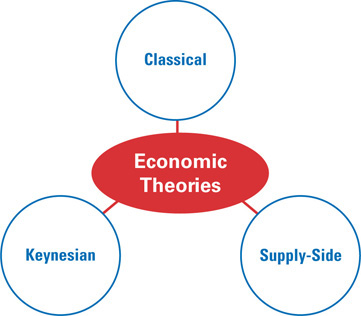Chapter 15 Assessment
Chapter Summary
A summary of major ideas in Chapter 15 appears below. See also the Guide to the Essentials of Economics, which provides additional review and test practice of key concepts in Chapter 15.
-
Section 1 Understanding Fiscal Policy (pp. 387–393)
The government can try to stabilize the economy through fiscal policy, or changing how much it taxes and spends. The tool it uses is the federal budget, which lists how much money the government expects to take in and how it will spend that money. Expansionary policies include lowering taxes and spending more to increase output. Contractionary policies include raising taxes and cutting spending to lower economic growth.
-
Section 2 Fiscal Policy Options (pp. 395–401)
The Great Depression of the 1930s seemed to disprove the idea that free markets always return to equilibrium. John Maynard Keynes argued that government spending can raise demand and help an economy recover. Keynesian economics drove American policy from the 1930s to the 1970s. In the 1980s, Ronald Reagan tried to increase output by putting supply-side economics into practice. He cut taxes to encourage people and businesses to work harder.
-
Section 3 Budget Deficits and the National Debt (pp. 403–408)
When the government spends more than it takes in, it runs a budget deficit and must create new money or borrow money to cover the difference. The government borrows money by issuing bonds. The national debt is all of the money the government owes to bondholders. The United States debt grew tremendously during the 1980s and early 1990s, causing problems for private businesses and leading to a public backlash against deficit spending. After a brief period of budget surpluses in the late 1990s, recession, tax cuts, and war caused massive new deficits in the early 2000s.
Key Terms
Choose the italicized word in parentheses that best completes each sentence.
- (Contractionary policies/Expansionary policies) are used to increase overall demand and GDP.
- The theory that states that the economy regulates itself best is known as (classical economics/Keynesian economics).
- A (Treasury note/Treasury bond) is a long-term bond, issued sometimes for as long as 30 years.
- (Budget surpluses/Budget deficits) occur when the government has money left over after paying all of its expenses for the year.
- The maximum sustainable economic output of a society is known as its (productive capacity/automatic stabilizer).
- A government's (fiscal year/fiscal policy) is the use of taxing and spending to affect the overall economy.
- The (national debt/balanced budget) is the total amount of money the federal government owes.
Using Graphic Organizers
-
Copy the web map below on a separate sheet of paper. Complete the diagram by filling in the primary characteristics of classical, Keynesian, and supply-side economics.





